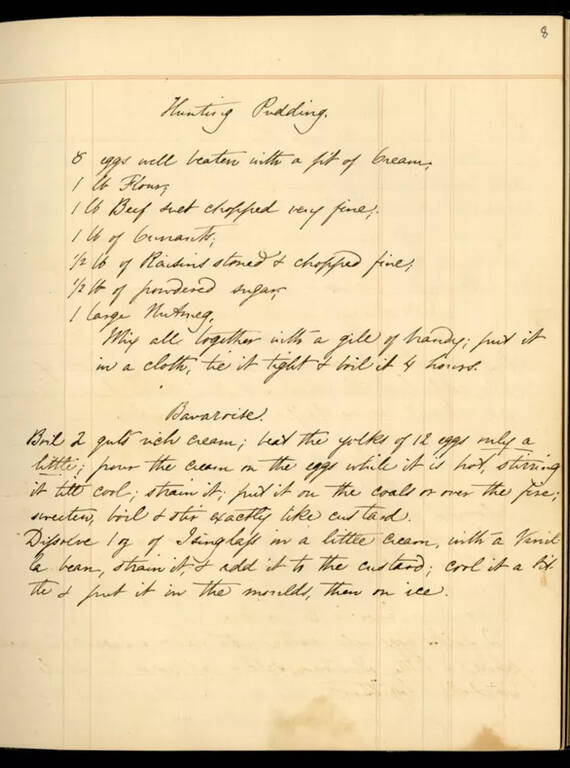What better way to celebrate the holidays than with food and drink! Here are 7 recipes with historical connections, shared online by national park sites.
1. Abigail Adams’ Apple Pan Dowdy
Adams National Historical Park, Massachusetts
Adams National Historical Park tells the stories of two presidents and their families. John Adams, who served as the nation’s second president, and wife Abigail lived on the property, and their oldest son, John Quincy Adams, became the country’s sixth president. Abigail Adams assumed the role of “patriot of the home front” during the American Revolution — she is said to have melted her pewter spoons to make musket balls for the Continental Army.
The historical park includes two homes, flower gardens and a historic orchard. Apple Pan Dowdy is a dessert recipe that is said to have come to the colonies through German immigrants to Pennsylvania. The National Park Service says Abigail may have picked up the recipe in Philadelphia, which served as the nation’s capital when Adams was vice president under George Washington.
Along with the recipe, the National Park Service offers a video of the dish being prepared by a hearth.
2. and 3. Wassail and Hot Buttered Rum
Fort Vancouver National Historic Site, Washington and Oregon
Fort Vancouver National Historic Site’s four locations interpret, in part, the history of a British fur trading fort and U.S. Army Post, as well as one of the largest multicultural villages in the Pacific Northwest. Residents of Fort Vancouver planted the first apple orchard in the region, started from seeds brought from England.
Wassail and hot buttered rum are among the historically inspired recipes shared by the park site, and both call for apple cider. A journal entry by a Fort Vancouver clerk in 1845 relayed how the fort’s workers received rum as a special addition to their rations on Christmas Eve 1845. Wassailing, according to the park site, can be interpreted as two traditions: visiting fruit trees and making noise to “wake” them into producing a good harvest the next year, as well as walking door to door, singing and offering a cider drink in exchange for a gift.
4. Fanny Longfellow’s Hunting Pudding
Longfellow House-Washington’s Headquarters National Historic Site, Massachusetts
This park site was home to one of the world’s foremost poets, scholars and educators of the 19th century, Henry Wordsworth Longfellow, and served as headquarters for General George Washington during the Revolutionary War.

A hand-written recipe for Hunting Pudding.
NPSLocated near Harvard University, the home became a center of culture and literature in the 1840s. The Park Service maintains archives and collections of Henry and Frances “Fanny” Longfellow that draws researchers from around the world.
Among the park site’s documents: a manuscript listing household goods and recipes kept by Fanny Longfellow, including Hunting Pudding.
Victorian families considered the dish, also known as plum pudding, a staple comfort food at the holidays. The recipe calls for beef suet, dried fruits, eggs, cream and brandy. In this video, you can watch a Park Service archivist make the dish.
5. Polish Hanukkah Apple Cake
Fort Stanwix National Monument, New York
Fort Stanwix National Monument tells the story of the Continental Army of the 1770s and its role in protecting an area of what’s now Upstate New York. Known as “the fort that never surrendered,” Fort Stanwix successfully resisted a prolonged siege in August 1777.
Jewish immigrants arrived in Manhattan in the 1650s as refugees from Brazil and were spread throughout colonial America by the time of the American Revolution. Many Jewish people served behind the lines and on the battlefields of the war for independence from Britain.
Hanukkah is an eight-day festival of lights celebrated by Jewish people. While not a specific 18th-century recipe, Fort Stanwix offers this version of Polish Hanukkah cake based on ingredients historians know would have been available in the area during colonial times.
6. Chicken Jubilee
Carl Sandburg Home National Historic Site, North Carolina
In 1945, poet Carl Sandburg and his wife, Lilian Paula Steichen, purchased an 1830s home near Flat Rock, North Carolina. The residence became Carl Sandburg Home National Historic Site when Lilian sold the property and all its belongings — recipe books included — to the National Park Service after her Pulitzer Prize-winning husband died in 1967.
The couple and their children enjoyed simple holidays at the property, known as Connemara, with handmade gifts and decorative greenery from their woods. Each December, the park site presents “Christmas at Connemara” with demonstrations and craft-making workshops. Among the family’s holiday recipes shared online is chicken jubilee, which calls for chili sauce and Bing cherries, a fruit from Lilian’s home state of Michigan.
7. Senate Bean Soup
U.S. Capitol, Washington, D.C.
In recognition of the role Congress plays in establishing and supporting national parks, we’re including traditional Senate Bean Soup in our list. This dish has been served daily in Senate restaurants for more than a century. The Senate website offers two versions of the recipe — one serving eight people and another that makes 5 gallons.
Since 1976, our country’s bicentennial year, the Capitol Hill Historic District has been part of the National Register of Historic Places. Learn how NPCA has been urging Congress to better fund parks.
Stay On Top of News
Our email newsletter shares the latest on parks.
About the author
-
 Linda Coutant Staff Writer
Linda Coutant Staff WriterAs staff writer on the Communications team, Linda Coutant manages the Park Advocate blog and coordinates the monthly Park Notes e-newsletter distributed to NPCA’s members and supporters. She is based in Western North Carolina.